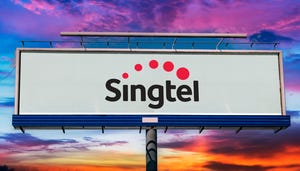Vendors Prepare for 40 Gigabit Future
Alcatel, Cyoptics, Lucent, and Nortel are rolling out OC768 developments
September 29, 2000

Several optical networking vendors are ramping up development of chips and devices that support OC768, and it looks like it won't be long before at least three of them are ready for use in optical networking gear.
Spokespeople at Alcatel SA (NYSE: ALA), for instance, say trials of OC768 gear are underway with three potential service-provider customers in the U.S. and Europe. While spokespeople declined to be specific, they indicated that Alcatel is "very interested" in the OC768 market and in staking a claim there.
Nortel Networks Corp. (NYSE/Toronto: NT) also says it's ready to go in this space. It's been demonstrating a transmission system it claims is capable of supporting rates from 40- to 80-Gbit/s since last October, and spokespeople say, "We'll be shipping 40-Gbit/s systems next year." Nortel declines to say, however, to what extent its own components are being used in the new gear.
Meanwhile, rumor has it that startup CyOptics Inc. will have samples of an indium phosphide OC768 chipset within the next two months. The startup itself won't be specific, but acknowledges that it plans to release an electro-absorption modulator and a pulse-generating laser. Both chips will be geared to vendors of equipment like edge switches for telecom networks.
Lucent Technologies Inc. (NYSE: LU) also seems far along in OC768 development. Earlier this month, it announced the R768, a 40-Gbit/s optical receiver for use in long-haul and submarine networking gear. Samples of this indium phosphide chip are available for $10,000 apiece. No information is available on who may be using it in prototypes or trials.
So what's it all mean for the market? Maybe not much, just yet. "We think this market won't take off until 2004, but by then it will probably be worth about $1.8 billion," says Lawrence Gasman, president of Communications Industry Researchers Inc., a consultancy. "But the big equipment vendors see this as a necessary next step. It's going to be a big deal."
The initial application for OC768 will be long-haul transmission, Gasman says, since that's likely to be where the need to add high speed to an existing Sonet infrastructure will first be felt among long-distance carriers. "Vendors like Williams and Worldcom are making plans to use it," he notes.
Notably, all of these developments are aimed at supporting single pipes with 40-Gbit/s capacity. As noted previously in Light Reading, at least one carrier, Enkido Inc., claims to be offering a commercial service at 40-Gbit/s (see Big Apple, Big Pipes). But that service is based on a conglomeration of smaller pipes. "There's a big difference technically between offering four OC192 connections and a single one at OC768," says Gasman. For one pipe a number of obstacles must be overcome.
For example, making chips that support rates four times faster than OC192 isn't technically simple. "Signal degradation is enhanced at higher speeds," says Hava Volterra, VP of marketing and business development at CyOptics. "Even generating a clean signal is a challenge." She says the use of substances like indium phosphide and lithium niobate, along with special modulation schemes, must be used to cope.
According to Volterra, OC768 is worth the work. "There's a bigger technical challenge, but we absolutely think this is going to be a big market," she says.
Other vendors reportedly working on OC768 components include the following:
The Lasertron division of Corning Inc. (NYSE: GLW), in a joint venture with startup Picometrix Inc.
Hitachi Ltd. (NYSE: HIT; Paris: PHA)
JDS Uniphase Inc. (Nasdaq: JDSU), through its Epitaxx subsidiary
PMC-Sierra (Nasdaq: PMCS)
Vitesse Semiconductor Corp. (Nasdaq: VTSS)
-- Mary Jander, senior editor, Light Reading http://www.lightreading.com
You May Also Like

.jpg?width=300&auto=webp&quality=80&disable=upscale)








